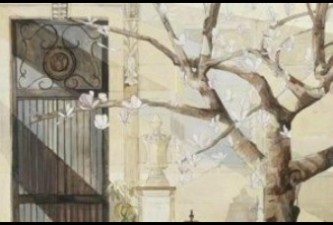
27/05/2015 13:40
Armenia, Africa stamp their past on art, as Genocide centennial museum opens in Watertown
“Kiss the Ground — A New Armenia (Part 3),” the culmination of a series of exhibitions marking the centennial of the Armenian Genocide, delineates the aftermath of trauma.
The first two (solo shows) were at the Armenian Library and Museum of America, in Watertown; this group show is at the Cambridge School of Weston’s Thompson Gallery, The Boston Globe reports.
That’s twofold trauma: the massacre of 1.5 million Armenians by forces of the Ottoman Empire between 1915 and 1922, and the Turkish government’s continued refusal to acknowledge that a genocide occurred.
The exhibition, curated by gallery director Todd Bartel, is sometimes furious, sometimes thoughtful and tender, sometimes clumsy. In all its colors, it reflects the experience of surviving trauma.
These contemporary artists grew up in households where parents or grandparents told them about the genocide — or didn’t talk about it at all. You can understand an urge to grab viewers by the lapels exclaiming, “This horror happened!”
Some of John Avakian’s monoprints — searing images built in part on historic photos — are almost too hard to look at. Political cartoons in an accompanying show by Lucine Kasbarian skewer Turkish officials and diplomatic responses pandering to their denial.
Satire has its place, but the best works in “Kiss the Ground” are less reactive. They question and explore the impact of the genocide. Art helps us to look at pain. Ideally, it makes space to help us comprehend and integrate even the most terrible losses.
Jessica Sperandio’s “Blue Smoke,” a wall-mounted cut acrylic work, describes a supine man under a knotty, spiky cloud. A genocide survivor inspired it: He came to the United States, worked at General Electric, and suffered a terrible head injury, after which he lay on the floor all day smoking. This is his desolate haze.
“Tattoo Trails I,” Adrienne Der Marderosian’s installation of prints, depicts hunched figures in long coats. She collages them with maps and cityscapes; figures repeat and disappear. They are disenfranchised; the sheer numbers make them an army of the lost.
Softer works, such as Gail Boyajian’s airy, lyrical “Romantic Landscape (Triptych),” which captures ruins of an Armenian church, and Marsha Odabashian’s “Allegorical Landscape,” lushly painted on separate rods leaning against the wall, evoke absence, and the effects of time passing.
In Kevork Mourad’s aching video “March 15,” a ghostly figure moves like vapor over a morphing cityscape. The figure is there yet not there; the city dissolves behind him. Mourad is a Syrian of Armenian origin, and his artist’s statement says this figure is a young Syrian. The echoes across a century and more of violence and ethnic strife in that region are harrowing.








